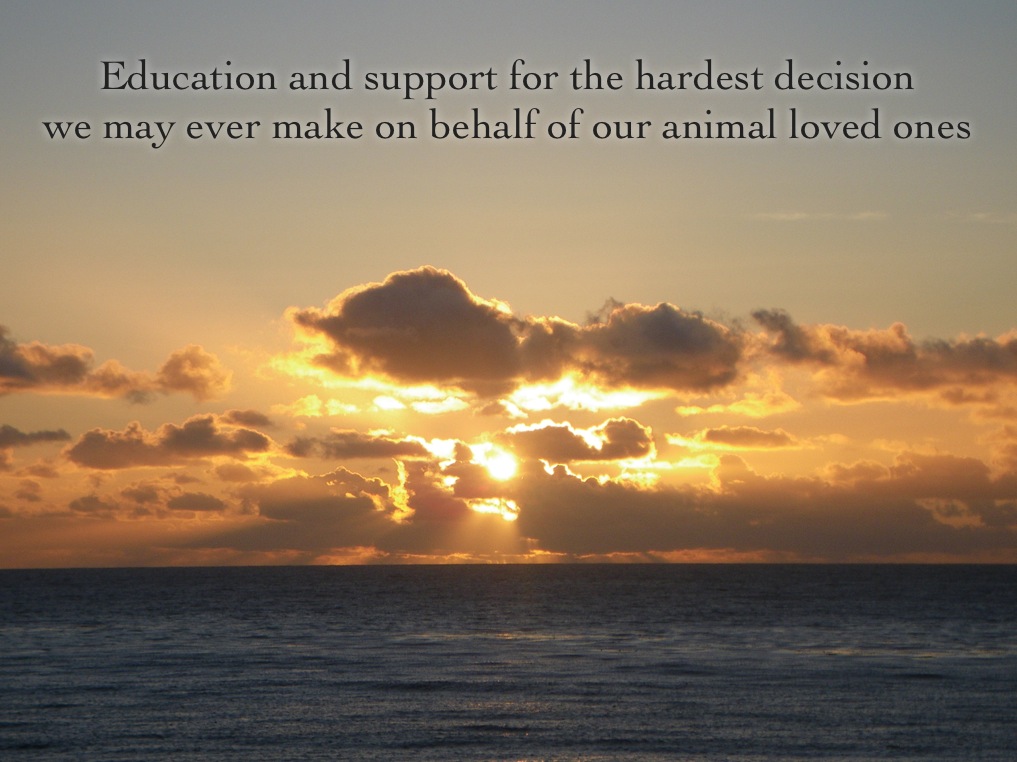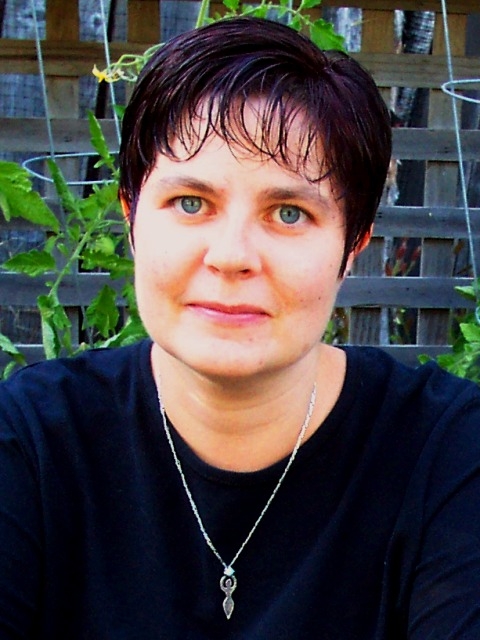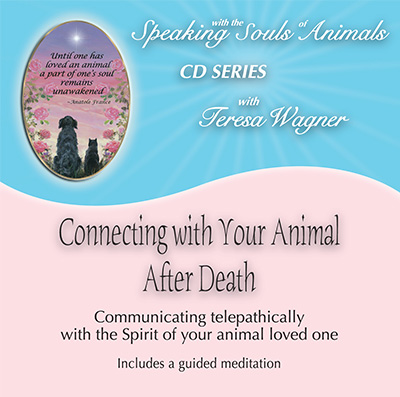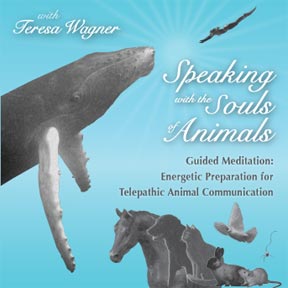Understanding and Preparing for Euthanasia

|
LENGTH: |
A 2 part teleclass: 2 hours each session for 4 total hours |
|---|---|
|
|
This is an on-demand teleclass to take anytime, at your convenience. |
|
COST: |
$98 Includes: |
|
|
Click here to purchase This class is one of many in the Animal Loss and Grief Support Training and Certification Program and is a required class for certification. |
|
INSTRUCTOR:
TESTIMONIALS: |
Windi Wojdak, RVT |
CONTENT AND PURPOSE:
For some of us, the mere thought of the day when we will lose our beloved companions to physical death is so full of dread and fear that we avoid any discussion or delay any planning of this inevitable event. Our own fears of death and loss can impact our ability to make the best choices for the animals in our care. Fear of the unknown can be a tremendous source of grief and can lead us to make decisions surrounding our animals' dying that we later regret. By facing our fears and questions before we are confronted with the trauma of an ailing loved one, we can better consider the choices and decisions we may need to make and take the time to develop plans or make changes that can lessen the sense of chaos and confusion to make our parting a time of shared love and connection.
In the right time and circumstances, providing a peaceful release for an ailing companion through euthanasia can be a powerful demonstration of love and respect. Education about the process of euthanasia can help us prevent surprises and minimize discomfort, stress or shock that can be part of the experience for humans saying goodbye to their animal companions. Advanced planning and consideration of our own questions, concerns, fears and beliefs about euthanasia can help us to make more informed decisions and create the best death experience possible for our animals when a choice for euthanasia has been made. If we are able to move past our own fears euthanasia can become a sacred act and a time of powerful connection.
It is very important to consider how our own needs and perceptions factor in to potential care decisions. It can be helpful to take some time to think about our relationship to death and dying, and to consider our underlying beliefs about euthanasia. When facing the death of our own cherished animal, this information can help us to shape an experience that will bring us closer to our companion and make their passing a time of deep honor and connection. When working with clients or others, a clear understanding of our own assumptions and beliefs can help us to remain clear and identify areas that may be triggers for judgment or misunderstanding.
While any discussion of death or dying will necessarily touch on our emotional and spiritual needs at this time, this course will focus primarily on the practical physical considerations regarding euthanasia with the goal of helping participants become more comfortable evaluating the options for their own animals and supporting clients or others in making end-of-life decisions for their companion animals.
• We will evaluate ways of thinking about and evaluating quality of life and other end of life issues.
• We will look at the process of euthanasia and physical death and consider ways to provide the
best process possible for our companions.
• We will discuss ways to help guide a sometimes clinical process to support our relationship with our animals at this sacred time.
Class Outline:
Session 1: Understanding Euthanasia
Defining Euthanasia
Euthanasia vs. Unassisted Death
Clinical Definitions
Anesthesia/Euthanasia and the Brain
Common Protocols for Euthanasia
The Process of Physical Death in Euthanasia
What You May Witness
Practical Decisions
Perspectives of the Veterinary Professional
Session 2: Considering and Preparing for Euthanasia
The Good Death
Facing Fears
Perceptions and Beliefs about Euthanasia
Is it Time? When to Consider Euthanasia
Factors to Consider
Facts / clinical information
Quality of life and pain assessment
Resources / abilities
Communication / insight
Support
Reasons for Euthanasia
Advance Directives
Allowing Flexibility
Dealing with Guilt
INSTRUCTOR: Windi Wojdak, RVT

Since becoming a licensed veterinary technician in 2000, she has worked to develop bridges between the veterinary and animal protection communities. She has taught various aspects of animal care and medicine to animal shelter staff and volunteers as well as veterinary students and professionals. She currently manages a national non-profit veterinary outreach program combining community service and veterinary education to bring free veterinary services to under-served rural communities throughout the world. Windi was honored for her work as the 2006 recipient of the California Veterinary Medical Association RVT of the Year award.
Her professional interests include shelter medicine, companion animal anesthesia and pain management, emergency medicine, euthanasia and end of life care. Windi has dedicated most of her life’s work to animal protection and advocacy and is continually in awe of the resiliency of spirit of those who suffer and those who strive to relieve suffering. She sees the act of euthanasia as a sacred responsibility and finds deep meaning in guiding animals and their human guardians through this important time.
COMMENTS FROM PARTICIPANTS
Just having a class on euthanasia has helped. It's been a lonely experience in the past as I've had to go alone and didn't have family or friends that were understanding or supportive. This class has a lot of tools that can be used to help others. The process, knowing that in the excitement stage the animal isn't conscious or in pain, the use of pain shots or sedative shots to help. The ways to spend time with the pet and honor the relationship. Also knowing that it's hard for the vet and staff. I've gained more compassion for the vet and how difficult it can be for them. Every question was well answered and explanations were easy to understand even though I'm not a vet tech.
~ Linda K, Willits, California
Very valuable class. The class was helpful in its scope of the subject of euthanasia, and, as a practicing animal communicator, I know the information given will be very useful in supporting animals and especially their people through what is often a difficult, stressful, and sad time. Most significant learning for me was what happens physically with euthanasia and the importance of good communication with the vet. Windi is a knowledgeable and compassionate presence, thank you!
~ Carla S, Rancho Cordova, California
This class was the first time I had heard the details of euthanasia. I appreciated Windi's eloquence in describing the various aspects of the process, including one's own belief system, physical capability of caregiver, and so many fine details in one package.
As soon as I completed the mp3 recordings and study of the outline, a client called to ask me to communicate with her dog about euthanasia vs. continued "pawspice" [hospice care] that she has been providing. She had broken down, felt guilty, felt incapable of continuing, and all of those things that Windi covered. I was so prepared to answer questions and help her understand some options, as well as to address her 'burnout'. Thank you, thank you.
~ Judy R. Chelsea, MI







